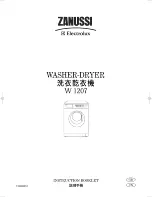
93
EN
11. PRACTICAL HINTS
Before placing the dishes in the
dishwasher, remove any remaining food
(bones, shells, pieces of meat or
vegetables, coffee grounds, skin of fruit,
cigarette ash, thooth picks etc. to avoid
blocking the filters, water outlet and
washing arm nozzles.
Try not to rinse the dishes before loading
them into the dishwasher.
If saucepans and oven dishes are
encrusted with the remains of burnt or
roast food, it is advisable to leave them to
soak before washing.
Place the dishes face downwards.
Try to place the dishes in such a way that
they are not touching one another. If they
are loaded properly you will get better results.
After loading the dishes check that the
washing arms can rotate freely.
Pans and other dishes that have
particularly stubborn food particles or
remnants of burnt food should be left to
soak in water with dishwasher detergent.
To wash silver properly:
a)
rinse the silver immediately after use,
especially if it has been used for
mayonnaise, eggs, fish etc.;
b)
do not sprinkle detergent onto it;
c)
keep it separate from other metals.
Tips on how to save money and not
damage the environment when using your
appliance.
Achieve the best use of energy, water,
detergent and time by using the
recommended maximum load size. Save
up to 50% energy by washing a full load
instead of 2 half loads.
If you want the dishwasher to give a
complete wash, place the dishes in the
dishwasher at the end of each meal and if
necessary turn on the COLD RINSE cycle
to soften the food remains and remove
bigger particles of food from the new load
of dishes. When the dishwasher is full
start the complete wash cycle programme.
If the dishes are not very dirty or if the
baskets are not very full select an
ECONOMY programme, following the
instructions in the program list.
The most efficient programmes in terms
of combined use of water and energy are
usually the longer-lasting ones with lower
temperature.
It should be remembered that not all
dishes are suitable for washing in a
dishwasher. We advise against using the
dishwasher to wash items in
thermoplastic, cutlery with wooden or
plastic handles, saucepans with wooden
handles, items in aluminum, crystal
leaded glass unless otherwise stated.
Certain decorations may fade. It is
therefore a good idea before loading the
whole batch to wash just one of the items
first so as to be sure that others like it will
not fade.
It is a good idea not to put silver cutlery
with non-stainless steel handles into the
dishwasher as there could be a chemical
reaction between them.
In order to avoid any dripping from the top
rack, remove the lower rack first.
If the dishes are to be left in the machine
for some time, leave the door ajar, to let
some air circulate and to improve the
drying performance.
Useful hints
When buying new crockery or cutlery
always make sure that they are
suitable for washing in a dishwasher.
What not to wash.
How to make savings.
How to get really good wash
results.
Summary of Contents for CDIN 1D360PB
Page 1: ...IT DE EN FR ...
Page 151: ......
















































